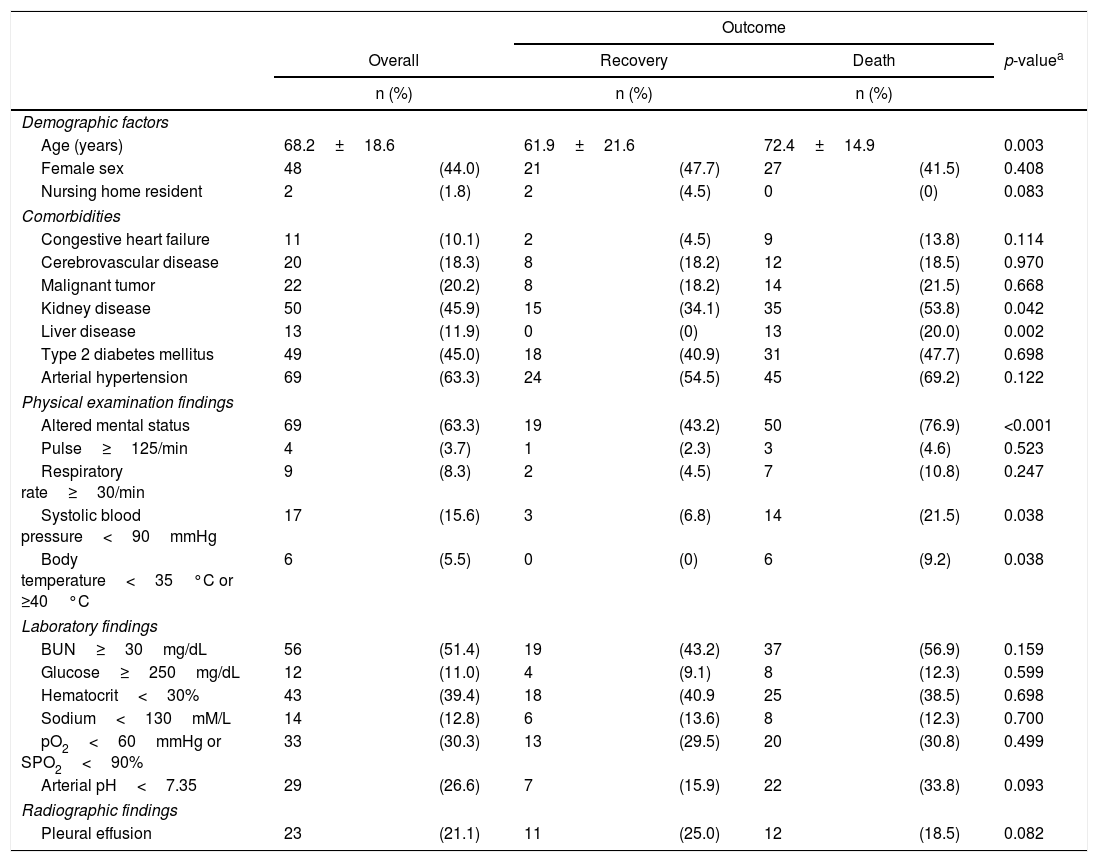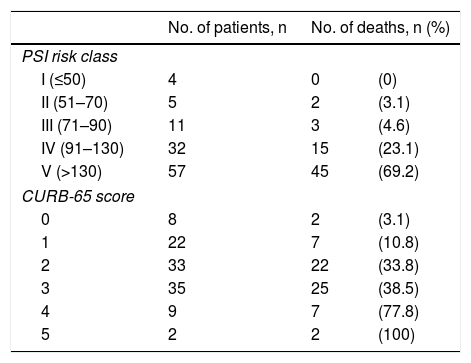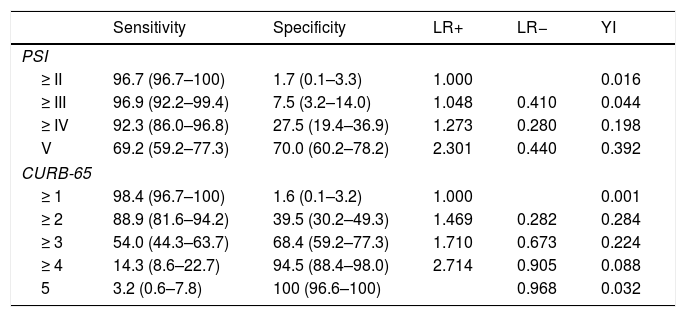Healthcare-associated pneumonia (HCAP) is the leading cause of infection in a hospital setting and is associated with a high mortality rate. This study aimed to evaluate the performance of the pneumonia severity index (PSI) and confusion, urea, respiratory rate, blood pressure, age≥65 (CURB-65) systems in predicting 30-day mortality in HCAP in adult patients.
Patients and methodsA cross-sectional study took place and data from 109 non-immunocompromised individuals aged>18 years were analyzed. The clinical diagnosis of HCAP included the presence of radiographic infiltrates in patients≥48h after hospital admission. The PSI and CURB-65 scores were calculated and performance measures were estimated. Summary statistics were used to describe the study sample. The PSI and CURB-65 scores were calculated based on 20 and 5 criteria, respectively, and the performance indicators of the screening tools were estimated.
ResultsThe overall 30-day mortality was 59.6%. At every given threshold, PSI sensitivity was higher, but showed a lower specificity than the CURB-65, and the highest Youden index (0.392) was observed at cut-off V in the PSI. The area under the ROC curve was 0.737 (95% CI: 0.646–0.827) and 0.698 (95% CI: 0.600–0.797) using the PSI and CURB-65 systems, respectively (p=.323).
ConclusionOur findings suggest that the performance of the PSI and CURB-65 is reasonable for predicting 30-day mortality in adult HCAP patients and may be used in healthcare settings.
La health care-associated pneumonia (HCAP, «neumonía asociada a la asistencia sanitaria») es la principal causa de infección hospitalaria y está asociada a una alta tasa de mortalidad. Este estudio tuvo como objetivo evaluar el desempeño de los sistemas Pneumonia Severity Index (PSI, «índice de gravedad de la neumonía») y Confusion, Urea, Respiratory rate, Blood pressure, 65 years of age and older (CURB-65, «confusión, urea, frecuencia respiratoria, presión arterial, edad≥65) en la predicción de la mortalidad a 30 días en pacientes adultos de HCAP.
Pacientes y métodosSe realizó un estudio de tipo transversal y se analizaron los datos de 109 individuos no inmunocomprometidos>18 años. El diagnóstico clínico de HCAP incluyó la presencia de infiltrados radiográficos en pacientes≥48h tras el ingreso hospitalario. Se calcularon las puntuaciones PSI y CURB-65 y se estimaron las medidas de rendimiento. Se utilizaron estadísticas resumidas para describir la muestra del estudio. Las calificaciones PSI y CURB-65 se calcularon sobre la base de 20 y 5 criterios, respectivamente, y se estimaron los indicadores de desempeño de las herramientas de cribado.
ResultadosLa mortalidad general a los 30 días fue del 59,6%. En cada umbral determinado, la sensibilidad del PSI fue mayor, pero mostró una especificidad más baja que el CURB-65, observándose el índice más alto de Youden (0,392) en el punto de corte v de PSI. El área bajo la curva ROC fue 0,737 (IC del 95%: 0,646-0,827) y 0,698 (IC del 95%: 0,6-0,797) utilizando los sistemas PSI y CURB-65, respectivamente (p=0,323).
ConclusiónNuestros resultados indican que el desempeño de PSI y CURB-65 es razonablemente bueno para predecir la mortalidad a 30 días en pacientes adultos de HCAP, pudiendo recomendarse o utilizarse en los centros de salud.
Artículo
Comprando el artículo el PDF del mismo podrá ser descargado
Precio 19,34 €
Comprar ahora











